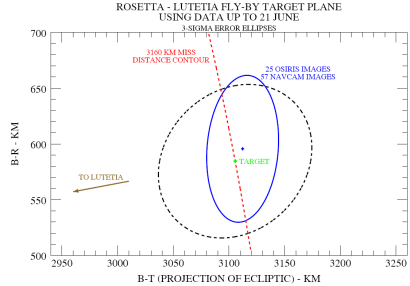Lutetia flyby navigation campaign up to 21 June 2010

Date: 24 June 2010
Satellite: Rosetta
Depicts: Rosetta - Lutetia flyby target plane
Copyright: ESA
This plot shows the situation in the target plane for Rosetta's flyby of asteroid Lutetia on 10 July 2010. It is based on radiometric data and ground-based astrometric data, as well as the optical navigation data from Rosetta's on-board cameras up to and including 21 June 2010.
The target plane is a planar coordinate system centred on the asteroid and is used for targeting during this close flyby. The target relative position of Rosetta for the flyby is marked in green and is 3160 km from asteroid Lutetia (at the origin of the plot, direction indicated with arrow).
Ellipses indicate 3-sigma error circles around Rosetta's determined positions (crosses) relative to the asteroid.
Up to 21 June, 30 images have been obtained with each of Rosetta's two navigation cameras (NAVCAMs) and 25 images with the OSIRIS narrow angle camera (NAC). These images of Lutetia and the stellar background have been reduced to provide 85 measurements of the direction from Rosetta to the asteroid. Three of the NAVCAM images were discarded, leaving 82 measurements for the orbit determination.
A trajectory correction manoeuvre (TCM) was performed on 18 June 2010, with a nominal magnitude of 27.5 cm/s, moving Rosetta's projected position in the target plane close to the target. The black, dashed error ellipse is associated with the nominal TCM, as predicted before the manoeuvre.
The blue cross and associated error ellipse shows the new solution in the target plane, after the TCM, based on the navigation data up to 21 June. Rosetta's projected position in the target plane now lies 3169 km from Lutetia and only 13 km from the target. The ellipse has semi-axes of 66 × 32 km. The predicted time of closest approach is 15:44:55.51 UTC with a 3-sigma uncertainty of 7.43 seconds.
A wider view of this plot, which includes the solution from before the TCM, is available from the right-hand menu under "related images".

